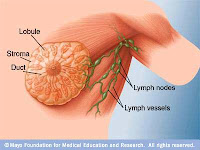Breast cancer is a malignant tumor that grows in the breast tissue. Cancer can begin to grow in the milk glands, milk ducts, fatty tissue, and connective tissue in the breast.
There are several types of breast cancer:
Carcinoma in situ
Carcinoma in situ means that cancer is still in place, an early cancer that has not spread or infiltrate out of the place of origin.
Ductal carcinoma
Ductal carcinomas originate from cells that line the channel leading to the nipple. Approximately 90% of breast cancer is ductal carcinoma. This cancer can occur before or after the menopause. Sometimes this cancer can be palpated and on the mammogram, the cancer appears as small spots of calcium deposits (microcalcifications). This cancer is usually limited to certain areas in the breast and can be surgically removed as a whole. Approximately 25-35% of patients with ductal carcinoma will develop invasive cancer (usually in the same breast).
Carcinoma lobuler
Carcinoma lobuler begin growing in the mammary gland, usually occurs after menopause. This cancer can not be felt and not seen on a mammogram, but are usually found incidentally on mammography performed for other purposes. Approximately 25-30% of patients with carcinoma lobuler will eventually suffer from invasive cancer (in the same breast or other breast or in both breasts).
Invasive cancer
Invasive cancer is cancer that has spread and damage other tissues, can be localized (confined to the breast) or metastatic (spread to other body parts). About 80% of invasive breast cancer is ductal cancer and 10% are cancer lobuler.
Medullary carcinoma
Cancer is derived from the mammary gland.
Tubular carcinoma
Cancer is derived from the mammary gland.
CAUSEThe cause is unknown, but there are some risk factors that cause a woman to be more likely to suffer from breast cancer.
Some risk factors are:
Of age.
About 60% of breast cancers occur in over 60 years of age. The greatest risk found in women aged over 75 years.
Ever had breast cancer.
Women who've had cancer in situ or invasive cancer has the highest risk for breast cancer. After the affected breast removed, then the risk of breast cancer in a healthy increase of 0.5-1% / year.
Family history of breast cancer.
Women who, mother, sister, or son, suffering from cancer have a risk three times more likely to suffer from breast cancer.
Genetic and hormonal factors.
Have found two variants of genes that appear to play a role in the occurrence of breast cancer, namely BRCA1 and BRCA2. If a woman has one of these genes, then the likelihood of breast cancer is very large. Other genes are also thought to play a role in the occurrence of breast cancer is p53, BARD1, BRCA3, and Noey2. This fact suggests that breast cancer is caused by growth of cells that are genetically damaged. Hormonal factors are also important because the hormone triggers cell growth. High levels of hormones during the reproductive period of women, especially if it is not interrupted by hormonal changes due to pregnancy, seems to increase the chances of growth of cells that are genetically have been damaged and cause cancer.
Had suffered from non-cancerous breast disease.
Risk of breast cancer is somewhat higher in women who had suffered from non-cancerous breast disease that causes the increase of the ducts and the occurrence of structural abnormalities of the breast tissue (atypical hyperplasia).
Menarche (first menstruation) before age 12, menopause after age 55 years, first pregnancy after age 30 years, or had never been pregnant. The earlier the menarche, the greater the risk of breast cancer. Risk of breast cancer is 2-4 times greater in women who experienced menarche before age 12 years. Similarly, menopause or first pregnancy. The slower the menopause and first pregnancy, the greater the risk of breast cancer
Use of birth control pills or estrogen replacement therapy.
Birth control pills may slightly increase the risk of breast cancer depends on age, duration of usage, and other factors. Not yet known how long the effects of the pill will still be there after pill use is stopped. Estrogen replacement therapy lived for over 5 years seems also slightly increase the risk of breast cancer and the risk is increased if a longer usage.
Obesity after menopause.
Obesity as a risk factor for breast cancer is still debated. Several studies suggest obesity as a risk factor for breast cancer, possibly because of high levels of estrogen in obese women.
The use of alcohol.
The use of alcohol more than 1-2 cups / day can increase the risk of breast cancer.
Of chemicals.
Several studies have mentioned the chemical exposure that mimic estrogens (contained in pesticides and other industrial products) may increase the risk of breast cancer.
DES (diethylstilbestrol).
Women who took DES to prevent miscarriage have a higher risk of breast cancer.
Irradiation.
Exposure to radiation (especially shines on the chest), in childhood can increase the risk of breast cancer.
Other risk factors.
Some studies indicate that uterine cancer, ovarian, and colon cancer as well as a history of cancer in the family can increase the risk of breast cancer.
SYMPTOMSEarly symptoms include a lump that is usually perceived differently than the surrounding breast tissue, painless and usually have an irregular edge. In the early stages, when driven by a finger, a lump can be moved easily under the skin. In later stages, the lump usually adheres to the chest wall or the surrounding skin. In advanced cancer, may develop a swollen lump or breast skin ulcers. Sometimes the skin over the lump shrank and looked like an orange peel.
Other symptoms that may be found:- Lump or mass in the armpit- Change the size or shape of the breast- An abnormal discharge from the nipple (usually bloody or yellow to green, may also be pus)- Changes in color or texture of the skin on the breast, nipple and areola (dark brown area around the nipple)- Breasts look red- The skin around the nipple scaly- The nipples are interested in or feel scratchy- Breast pain or swelling of one breast.
In later stages may develop bone pain, weight loss, swelling of arms or skin ulceration.
FilteringCancer at early stages rarely produce symptoms, because it is very important to do the filtering. Some of the procedures used for breast cancer screening:
BSE (Breast Self-Examination).
If done regularly BSE, a woman will be able to find a lump in the early stages. BSE should be done at the same time every month. For women who still menstruate, the best time to do BSE is 7-10 days after the first day of menstruation. For postmenopausal women, can be done anytime, but are routinely conducted every month (eg every month).
Mammography.
On mammography use low-dose X-rays to find abnormal areas in the breast. The experts recommend to every woman over the age of 40 years to perform routine mammograms every 1-2 years and at age 50 years and over a mammogram done once / year.
Breast ultrasound.
Ultrasound is used to distinguish a cyst (fluid-filled sac) with a solid lump.
Thermography.
At temperatures of thermography used to find abnormalities in the breast.
BSE (Breast Self-Examination)
Standing in front of the mirror, look at the breast. Under normal circumstances, the size of the left and right breast is slightly different. Note the change of size differences between left and right breast and nipple changes (for example, are interested in) or discharge from the nipple. Note whether the wrinkled skin on the nipple.
Still standing in front of a mirror, placed both hands behind his head and his hands pulled back. With this position it will be easier to find small changes due to cancer. Notice the change in shape and contour of the breast, especially on the bottom of the breast.
Both hands are placed on the waist and the body leaning slightly toward the mirror, press your shoulders and elbows forward. Note the change in size and contour of the breast.
Raise your left arm. By using 3 or 4 finger right hand, scan the left breast. Move your fingers to play (small circle) around the breast, starting from the outer edge of the breast and then move inward to the nipple. Press gently, feel any lump or mass under the skin. Do the same thing on the right breast by lifting his right arm and examined it with his left hand. Note also the area between the two breasts and armpits.
Click the nipple gently and see if discharge from the nipple. Do this alternately on the left and right breast.
Lying supine with a pillow placed under the left shoulder and left arm is pulled up. Search the left breast using your right hand fingers. With this position, the breast will be flattened and facilitate the examination. Do the same thing on the right breast by placing a pillow under your right shoulder and raised his right arm, and breast searches conducted by the fingers of his left hand.
Examination of 4 and 5 will be easier to do when a shower because wet hands more easily mobilized and skin more slippery.DiagnosisDiagnosis based on symptoms, physical examination results and the results of the following:
Biopsy (taking samples of breast tissue for examination under a microscope)
Chest X-rays
Blood tests to assess liver function and the spread of cancer
Skening bone (performed if the tumor is large or is found enlarged lymph nodes)
Mammography
Breast ultrasound.
Staging (Determination Stage Cancer)Staging of cancer treatment is important as a guide, follow up and determine the prognosis. Staging of breast cancer (American Joint Committee on Cancer):- Stage 0: Cancer in situ where the cancer cells are in place in the normal breast tissue- Stage I: Tumor with a diameter of less than 2 centimeters and has not spread beyond the breast- Stage IIA: The tumor with a diameter of 2-5 cm and has not spread to underarm lymph nodes or tumors with a diameter of less than 2 centimeters but has spread to underarm lymph nodes- Stage IIB: The tumor with a diameter larger than 5 centimeters and has not spread to underarm lymph nodes or tumors with a diameter of 2-5 cm but has spread to underarm lymph nodes- Stage IIIA: The tumor with a diameter of less than 5 centimeters and has spread to underarm lymph nodes accompanied by adhesions to one another or adhesions to other structures, or tumors with diameters of more than 5 centimeters and has spread to underarm lymph nodes- Stage IIIB: The tumor had infiltrated out of the breast, ie into the skin of the breast or chest wall or has spread to lymph nodes inside the chest wall and sternum- Stage IV: Tumor has spread beyond the breast and chest wall, such as the liver, bones or lungs.
In addition to cancer stage, there are other factors that influence the type of treatment and prognosis:
Types of cancer cells
Overview of cancer
Cancer response to hormone
Cancers that have estrogen receptors grow more slowly and more frequently found in postmenopausal women.
Presence or absence of breast cancer causing gene.
Read our popular entries:
Treatment for breast cancer
What is hypertension??
Brief of asthma
Visit our popular blog:
Fashionable
Popular Entry
- Getting rid of worms with Herbs
- Yogurt Prevent Gastritis and Stomach Ulcer
- Coffee Tribulus for Vitality and Stamina
- Minimize negative effects of smoking
- 6 Point Stimulation Shocking
- Efficacy and benefits of papaya
- Five natural ingredients that address the Fat
- Aloclair Gel, Drugs for Sprue
- Quick having Pregnant and Having Children
- Efficacy cashew



